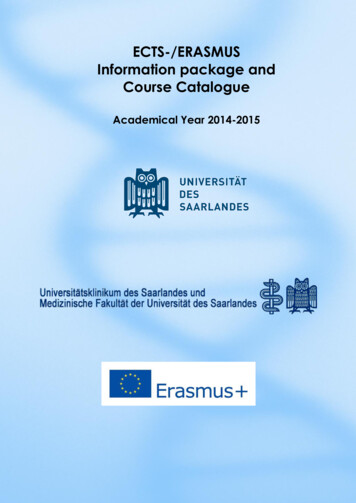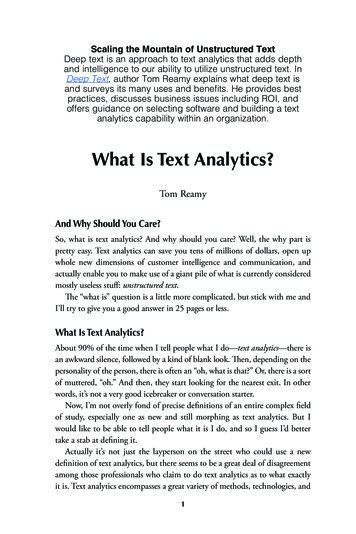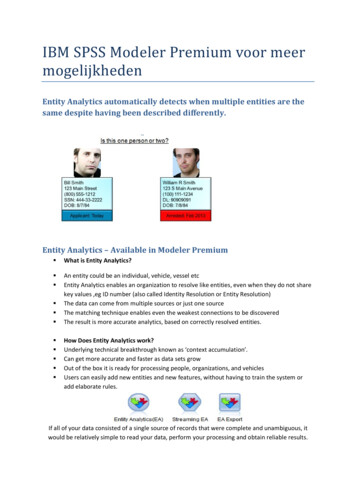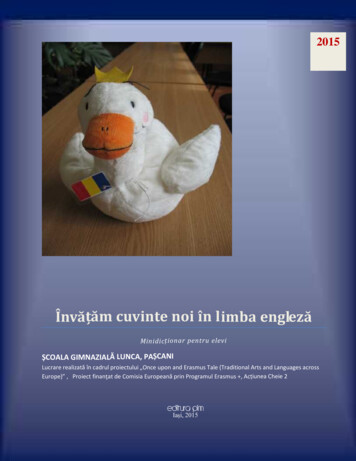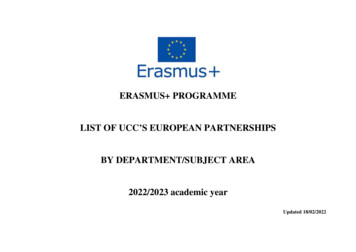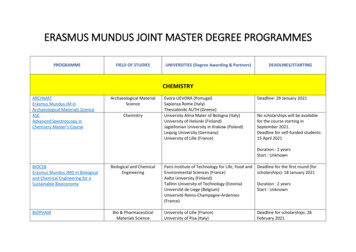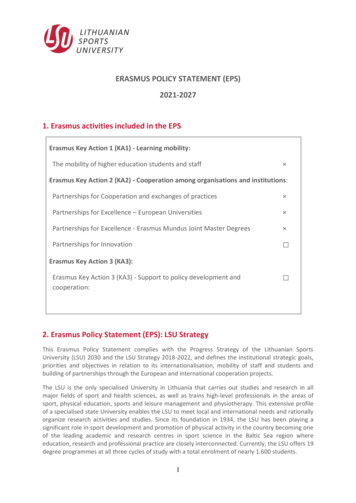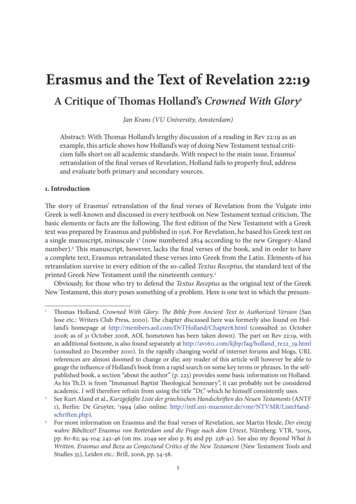
Transcription
Erasmus and the Text of Revelation 22:19A Critique of Thomas Holland’s Crowned With Glory1Jan Krans (VU University, Amsterdam)Abstract: With Thomas Holland’s lengthy discussion of a reading in Rev 22:19 as anexample, this article shows how Holland’s way of doing New Testament textual criticism falls short on all academic standards. With respect to the main issue, Erasmus’retranslation of the final verses of Revelation, Holland fails to properly find, addressand evaluate both primary and secondary sources.1. IntroductionThe story of Erasmus’ retranslation of the final verses of Revelation from the Vulgate intoGreek is well-known and discussed in every textbook on New Testament textual criticism. Thebasic elements or facts are the following. The first edition of the New Testament with a Greektext was prepared by Erasmus and published in 1516. For Revelation, he based his Greek text ona single manuscript, minuscule 1r (now numbered 2814 according to the new Gregory-Alandnumber).2 This manuscript, however, lacks the final verses of the book, and in order to havea complete text, Erasmus retranslated these verses into Greek from the Latin. Elements of hisretranslation survive in every edition of the so-called Textus Receptus, the standard text of theprinted Greek New Testament until the nineteenth century.3Obviously, for those who try to defend the Textus Receptus as the original text of the GreekNew Testament, this story poses something of a problem. Here is one text in which the presum123Thomas Holland, Crowned With Glory. The Bible from Ancient Text to Authorized Version (SanJose etc.: Writers Club Press, 2000). The chapter discussed here was formerly also found on Holland’s homepage at http://members.aol.com/DrTHolland/Chapter8.html (consulted 20 October2008; as of 31 October 2008, AOL hometown has been taken down). The part on Rev 22:19, withan additional footnote, is also found separately at http://av1611.com/kjbp/faq/holland re22 19.html(consulted 20 December 2010). In the rapidly changing world of internet forums and blogs, URLreferences are almost doomed to change or die; any reader of this article will however be able togauge the influence of Holland’s book from a rapid search on some key terms or phrases. In the selfpublished book, a section “about the author” (p. 223) provides some basic information on Holland.As his Th.D. is from “Immanuel Baptist Theological Seminary”, it can probably not be consideredacademic. I will therefore refrain from using the title “Dr.” which he himself consistently uses.See Kurt Aland et al., Kurzgefaßte Liste der griechischen Handschriften des Neuen Testaments (ANTF1), Berlin: De Gruyter, 21994 (also online: riften.php).For more information on Erasmus and the final verses of Revelation, see Martin Heide, Der einzigwahre Bibeltext? Erasmus von Rotterdam und die Frage nach dem Urtext, Nürnberg: VTR, 42005,pp. 80-82; 94-104; 242-46 (on ms. 2049 see also p. 85 and pp. 238-41). See also my Beyond What IsWritten. Erasmus and Beza as Conjectural Critics of the New Testament (New Testament Tools andStudies 35), Leiden etc.: Brill, 2006, pp. 54-58.1
2Erasmus and the Text of Revelation 22:19ably uninterrupted line of transmission is demonstrably broken. Only a miracle could have madeErasmus produce exactly the same text as the original Greek, and such a miracle did not happen.Let me state from the start that the entire enterprise of trying to defend the Greek TextusReceptus is pointless. Sometimes even the obvious has to be stated, unfortunately. Well then,even if the leaf with the final verses of Revelation had still been part of the manuscript that wasused for that part of the New Testament, or if Erasmus had had a far better manuscript for Revelation as a whole, the character of the Textus Receptus in general would not have been different. The circumstances under which it was produced are known only too well: the manuscriptsthat were used, the working conditions of editors, copyists and typesetters, the knowledge andskills in (Greek) textual criticism at that time, and finally the aims the editors, beginning withErasmus, had. Not much historical insight and knowledge is needed to see that this combination of factors, partly coincidental and partly historically determined, could never produce ascholarly good Greek text of the New Testament, let alone the best attainable Greek text. Thedefence of the sixteenth-century text can only be inspired by an—unfortunate—theological apriori, not by the historical facts. It could be mentioned in passing that Erasmus never presented the Greek text of his editions as God’s bible itself. It was simply the underlying text ofhis own translation. Moreover, there are historical questions far more interesting than the textcritical value of this text. For instance, why did Erasmus’ text become “received” so rapidly?Why were Erasmus’ decisions and practice hardly challenged?The issue addressed in this article, however, is far more limited. Some misinformation isspreading, especially on the Internet, according to which the traditional story of Erasmus andthe final verses of Revelation is challenged. The most important source of this misinformation,as one rapidly finds out, is Thomas Holland’s book Crowned With Glory, parts of which are alsoaccessible on the Internet.4 Holland’s prominent source in turn is Hoskier’s work on the Greektext of Revelation.5 It is unclear whether he consulted Hoskier directly, or used an intermediatesource such as Hills.6In the following paragraphs, I will discuss what Holland writes on Erasmus’ dealing withthe final verses of Revelation, by quoting exactly what he writes and commenting on it, at thesame time providing some background information and some occasional random thoughts.2. Holland and Revelation 22:19The issue Holland takes on in order to address Erasmus’ work on the final verses is an interesting variant reading in Rev 22:19: “. and if any man shall take away from the words of the bookof this prophecy, God shall take away his part from the tree of life, and out of the holy city,which are written in this book” (nrsv). He writes:While the focus of this verse deals with the phrase “book of life,” as opposed to “tree of life,” theissue is deeper. (p. 168)Why this reading “book of life” is important to him will be explained later. First he tackles thequestion of the reading’s source.456See the first footnote; I will only discuss the relevant parts of chapter eight, “Textual Considerations” (pp. 143-72); the section on Rev 22:19 is found on pp. 168-72.Herman C. Hoskier, Concerning the Text of the Apocalypse. Collations of All Existing Available GreekDocuments With the Standard Text of Stephen’s Third Edition Together With the Testimony of Versions, Commentaries and Fathers. A Complete Conspectus of All Authorities, 2 volumes, London:Bernard Quaritch, 1929.Edward Freer Hills, The King James Version Defended, Des Moines: CRP, 41984.
Erasmus and the Text of Revelation 22:1933. What Erasmus Himself Wrote on the Issue of the Final VersesHolland continues:The manuscript Codex 1r used by Desiderius Erasmus in the production of his Greek New Testament is missing the last six verses of Revelation chapter twenty-two. It is thought that Erasmustook the Latin Vulgate and retranslated these verses back into Greek. (p. 168)The minuscule manuscript is now known under two numbers, the old one being 1r and thenew one 2814. It is also named Codex Reuchlini (or Capnionis after Reuchlin’s latinizedname), for Erasmus borrowed it from Reuchlin.7 It is one of the many manuscripts in whichAndreas’ commentary is put between the text. It is often stated that the problem concernsthe final leaf that is missing, but it actually concerns the leaf with, besides part of the commentary, the final verses of the text, to wit Rev 22:16-21, from the words ὁ ἀστήρ at the end ofverse 16 onwards.Note that Holland here already qualifies the story of Erasmus’ retranslation as a “thought”.In a footnote, he indicates and discusses only one source for it:Erika Rummel, Erasmus’ Annotations on the New Testament: From Philologist to Theologian(Toronto: University of Toronto Press, 1986), 93. (p. 168 n. 256)The passage referred to by Holland is found on p. 193 (not 93) in Rummel’s book,8 where in n.15 to p. 38 she writes:. In Reuchlin’s manuscript [2814] the last six verses were missing and Erasmus retranslatedthe Vulgate into Greek. He made no secret of this: ex Latinis adiecimus (Annotationes of 1516page 675); ex nostris Latinis supplevimus Graeca (lb ix 246c); and he countered Lee’s indignantremarks by declaring nonchalantly that he had merely wished to avoid a “gaping lacuna” in thetext (ne hiaret lacuna, lb ix 246c).This is important information, and Holland uses it in his own footnote. Let us however seehow he does that; he writes:It is claimed that Erasmus openly declares in the Annotations of his 1516 edition (page 675) thathe “ex nostris Latinis supplevimus Graeca” (supplied the Greek from the Latin). Thus the claimthat the last six verses of Revelation chapter twenty-two were retranslated from the Vulgate intoGreek. However, the reprint of the 1516 edition of Erasmus does not contain this phrase on page675 of his Annotations, which is the conclusion of his notes on the book of Revelation, nor issuch a phrase found elsewhere in that edition. (p. 168 n. 256)As this is still part of Holland’s footnote, it suggests that the “claim” is derived from Rummel’sbook. If so, it is based on an astonishing misreading of Rummel’s remarks, for she refers toErasmus’ Annotationes for the words “ex Latinis adiecimus”, not for the ones Holland looks forthere. For the latter, “ex nostris Latinis supplevimus Graeca”, she refers to lb ix, but one getsthe impression that Holland does not even know that among Erasmus scholars lb stands forthe old Leiden edition of the Opera omnia edited by Clericus.9789As such to be distinguished from another Codex Reuchlini, min. 1 (1eap).Erika Rummel, Erasmus’ Annotations on the New Testament. From Philologist to Theologian (Erasmus Studies 8), Toronto: University of Toronto Press, 1986.See e.g. Rummel, Annotations, p. 221. The Leiden edition was published in 1703-1706 and republished by Olms in Hildesheim in 1961-1962. It can be found online at the Erasmus Center for EarlyModern Studies (http://www.erasmus.org). lb stands for “Lugdunum Batavorum”, the Renaissancename for Leiden (the real Roman Lugdunum in the Low Countries was near present-day Katwijk).
4Erasmus and the Text of Revelation 22:19Even without Rummel’s information, which is correct, Erasmus’ retranslation is commonknowledge, and exact indications are not hard to find. What then is found on page 675 in the1516 Annotationes? Rummel says it and Holland ignores it: “ex latinis adiecimus” (“we added[them] from the Latin”). In full:10Quamquam in calce huius libri nonnulla verba reperi apud nostros quae aberant in Graecisexemplaribus; ea tamen ex latinis adiecimus.However, at the end of this book, I found somewords in our versions which were lacking in theGreek copies, but we added them from the Latin.Holland, who probably consulted Holeczek’s facsimile edition,11 did not find the words he waslooking for after having misread Rummel’s note, or the words that were actually indicatedby Rummel. He obviously did not even read Erasmus’ final annotation (on the words “etiamvenio cito” of Rev 22:20) attentively enough to find in its third line Erasmus’ statement citedabove, which in itself is clear enough to show in his own words what Erasmus did.12 The mostpuzzling is actually his remark “nor is such a phrase found elsewhere in that edition”. Do wereally have to assume that Holland read all of Erasmus’ Annotationes?And what about the other words cited by Rummel, and looked for in vain by Holland?These words, “ex nostris Latinis supplevimus Graeca”,13 do not come from the Annotationes,but, as Rummel indicates, from his apology against Lee. The common abbreviation for thiswork is Resp. ad annot. Ed. Lei.14 Herein, Erasmus counters a large number of criticisms levelled against his New Testament project. Before 2004, it was only available in the ninth volumeof the Leiden edition (lb ix),15 but recently ASD IX-4 was published, the fourth volume of theninth “ordo” of the Amsterdam edition, edited by none other than Rummel.16 There now evenis an English translation, also by Rummel, as part of the Toronto Collected Works of Erasmus.10111213141516English translations are my own unless otherwise stated. The sentence is omitted from Erasmus’second edition (1519) onwards, probably because he erroneously thought that the text had been corrected. The relevant part is reproduced and marked here in appendix 3. Note there the correctionof the page number; 675 is indeed an error for 625, but in early printed books, such errors are verycommon; it seems that in some copies actually the correct 625 is printed.Novum instrumentum. Faksimile-Neudruck mit einer historischen, textkritischen und bibliographischen Einleitung by H. Holeczek, Stuttgart: Frommann-Holzboog, 1986. To call this edition a“reprint” betrays a somewhat strange choice of words in this context, though one could speak abouta “photomechanic reprint”.Interestingly, Hoskier, an important source for Holland in his case against the retranslation story,quotes the same words (“ea . adiecimus”) in his Apocalypse 2, p. 637.They mean: “we supplied the Greek [words] from our Latin [text]”; the way Holland puts the wordsin his text is somewhat odd.In full: Responsio ad annotationes Eduardi Lei (“Answer to Edward Lee’s Annotations”).And of course in the original edition, if one could find a copy in a library; the 1520 Basle edition isnow available on the Internet, as part of the Digitale Bibliothek of the Bayerische StaatsBibliothek(see http://mdz10.bib-bvb.de/ db/0002/bsb00021857/images/, consulted 15 October 2008). Erasmus’ discussion of the final verses can be found on pp. 226-32 (esp. pp. 226-27). In the originaledition, one can also find Lee’s annotations (Annotationes Edouardi Leei in annotationes Novi Testamenti Desiderii Erasmi, pp. 141-42). Lee quotes Erasmus’ 1516 note, and asks why Erasmus did notdo the same more often throughout the New Testament. Lee’s interest, of course, is that the procedure demonstrates the authority and value of the Vulgate against the corrupted Greek manuscripts.This polemic context is also the background of Erasmus’ reaction.The Amsterdam edition of Erasmus’ Opera omnia (asd) is a work in progress, which started in 1969.Volumes from 1999 onwards are published by Elsevier. Simultaneously, the Toronto edition of theCollected Works of Erasmus (cwe) contains English translations and annotations for a wider audience.
Erasmus and the Text of Revelation 22:195In ASD IX-4, the passage on Revelation is found at p. 278, as follows (with the CWE translation alongside):17Dubium non erat quin essent omissa, et erant perpauca. Proinde nos, ne hiaret lacuna,ex nostris Latinis supplevimus Graeca. Quodipsum tamen noluimus latere lectorem, fassiin annotationibus quid a nobis esset factumut, si quid dissiderent verba nostra ab his quaeposuisset autor huius operis, lector nactus exemplar restitueret. . Et tamen hoc ipsum noneramus ausuri in Euangeliis, quod hic fecimus,ac ne in epistolis quidem apostolicis. Huius libri sermo simplicissimus est, et argumentumfere historicum, ne quid dicam, de autore olimincerto. Postremo locus hic coronis tantum estoperis.There was no doubt that the words had beenomitted, and they were only a few. To avoidleaving a lacuna in my text, I supplied theGreek out of our Latin version. I did not wantto conceal this from the reader, however, andadmitted in the annotations what I had done.My thought was that the reader, if he had accessto a manuscript, could correct anything in ourwords that differed from those put by the authorof this work. . And yet I would not have daredto do in the Gospels or even in the apostolicEpistles what I have done here. The languageof this book is very simple, and the content hasmostly a historical sense, not to mention thatthe authorship was once uncertain. Finally, thispassage is merely the conclusion of the work.Not knowing what lb is or who Lee was, Holland did not consult this passage, but tried to findthe words indicated in Rummel’s footnote in the 1516 Annotationes. Ironically, Erasmus himselfrefers to the Annotationes just a few lines below the very words quoted by Rummel, as we see.There is even a third place in Erasmus’ works where the issue is discussed, already mentioned by Delitzsch.18 The passage, from another, earlier writing against Lee, is as follows:19In calce Apocalypsis in exemplari quod tumnobis erat unicum (nam is liber apud Graecosrarus est inventu), deerat unus atque alter versus. Eos nos addidimus, secuti Latinos codices.Et erant eiusmodi ut ex his quae praecesserantpossent reponi. Cum igitur Basileam mitteremrecognitum exemplar, scripsi amicis ut ex aeditione Aldina restituerunt eum locum. Nammihi nondum emptum erat hoc opus. Id ita, utiussi, factum est. Queso, quid hic debetur Leo?An ipse quod deerat restituit? Atqui nullumhabebat exemplar nisi meum. Sed admonuit.Quasi vero non hoc testatus sim in prioribusannotationibus, quid illic egissem et quid desyderarem.At the end of the Apocalypse, the manuscriptI used (I had only one, for the book is rarelyfound in Greek) was lacking one or two lines. Iadded them, following the Latin codices. Theywere of the kind that could be restored out ofthe preceding text. Thus, when I sent the revised copy to Basel, I wrote to my friends torestore the place out of the Aldine edition; forI had not yet bought that work. They did as Iinstructed them. What, I ask you, do I owe toLee in this case? Did he himself restore whatwas missing? But he had no text except mine.Ah, but he warned me! As if I had not stated inthe annotations of the first edition what I haddone and what was missing.Erasmus’ words, as always, raise interesting questions, which cannot be addressed here. However the conclusion is obvious: from Erasmus’ own writings, at at least three different occa171819Resp. ad annot. Ed. Lei, ASD IX-4, p. 278 ll. 35-39 and 39-43; cf. p. 120 ll. 303-304: “. quod in fineApocalypsis paucula verba adiecerim Graeco codici ex nostris Latinis” (“. that at the end of Revelation I added some words to the Greek book on the basis of our Latin ones”). Translation Erika Rummel, CWE 72, p. 344. Instead of “the authorship was once uncertain”, I would prefer, with anothernuance of “olim”, “the authorship has long since been uncertain”.Franz Delitzsch, Handschriftliche Funde. Erstes Heft: Die Erasmischen Entstellungen des Textes derApokalypse, nachgewiesen aus dem verloren geglaubten Codex Reuchlins, Leipzig: Dörffling undFrancke, 1861, p. 14.Apolog. resp. inuect. Ed. Lei (Apologia qua respondet duabis inuectiuis Eduardi Lei), ASD IX-4, pp.54-55 ll. 894-914. Translation Erika Rummel in CWE 72, p. 44.
6Erasmus and the Text of Revelation 22:19sions, it is proven beyond a shadow of a doubt that he retranslated the final verses of Revelation from the Vulgate into Greek. The exact scope of the retranslation is not indicated byErasmus, but it obviously concerns the lacuna in min. 2814: Rev 22:16-21, from 16 ὁ ἀστήρonwards.20The only conclusion, so far, can be that Holland did not do his homework. There are simplytoo many articles on the issue and the primary sources are not too difficult to deal with. We areactually presented with a rather nasty choice here: either Holland knows better and knowinglyobscures the issue, or he really thought that his failure to corroborate one piece of information settles the issue. Perhaps the latter is to be preferred: his eagerness to demonstrate thecorrectness of the Textus Receptus obscured his better judgement. This problem, in my view,constitutes a pattern throughout Holland’s book.4. Two Lines of DefenceAnd this sloppy (lack of) scholarship is only what Holland produces when he investigatesErasmus’ own statements on the issue. Let us see what happens when he looks at the biblicaltexts themselves. He writes:Assuming this hypothesis is true we must ask ourselves the following questions. First, if Erasmus did make use of the Latin Vulgate to supply these last six verses, has the usage of the Latincorrupted the text? Second, was Codex 1r really the only Greek manuscript used by Erasmus forthis passage? (p. 168)Min. 2814 (1r) was of course not used for these verses, otherwise there would have been noproblem to start with. More importantly, the story has now become an “hypothesis”, which ingood Popperian tradition cannot wait to be falsified. Interestingly as well, Holland’s two linesof defence are clear by now. According to the first, retranslation from the Latin does not posea problem, and can even result in a reliable text. According to the second, there were otherGreek sources Erasmus could use, and therefore no retranslation took place.If either one of these lines is correct, the other becomes unnecessary. Pursuing the secondline—there was no retranslation—actually implies that the first line—retranslation is not aproblem—is not perceived as sufficient defence of the Textus Receptus.5. The Character of Erasmus’ Greek TextHaving ignored the “external evidence” (i.e., Erasmus’ own statements), Holland tries to produce some “internal evidence”, that is, evidence derived from the Greek text itself. He introduces this part of his argument as follows:Certainly the Latin Vulgate and the Greek Textus Receptus are similar in these last six verses.This, of course, would be natural if the Latin was based on early Greek manuscripts that correspond with the Textus Receptus. We must remember that most of the Greek manuscripts of thesecond, third, and fourth centuries have not survived the passage of time. (p. 168)20Even without having recourse to min. 2814, for the manuscript was lost at that period, Wettsteinin the first half of the eighteenth century correctly analysed the scope of Erasmus’ retranslation asRev 22:16-21 (see Johann Jacob Wett stein, Prolegomena ad Novi Testamenti Graeci editionem accuratissimam ., Amsterdam: Wetstenii & Smith, 1730, pp. 139-40, and idem, Novum TestamentumGraecum, 2 vols., Amsterdam: Officina Dommeriana, 1751-1752 (photomechanical reprint, Graz:Akademische Druck- und Verlagsanstalt, 1962), 1, pp. 126-27). In the 1730 Prolegomena, Wettsteincites Erasmus’ 1516 annotation and his 1520 Responsio; in his NTG, he cites also the Apologia.
Erasmus and the Text of Revelation 22:197This is a description of what he imagines: the final verses were taken from a Greek manuscript;similarity with the Vulgate text can be explained simply by the fact that the Vulgate itself depends on a Greek text. Holland continues:However, the Vulgate and the Textus Receptus are not identical either. For example, the conclusion of Revelation 22:20 reads in the Receptus, Amen. Nai, erchou, kurie Iesou (Amen. Even so,come Lord Jesus). The Latin reads, amen veni Domine Iesu (Amen come Lord Jesus). The TextusReceptus includes an additional affirmation nai (even so), an addition not found in either theGreek Critical Text or the Latin Vulgate. (pp. 168-69)Holland, in other words, finds an unexplainable difference between Erasmus’ (according toHolland presumed) Vorlage, the Vulgate text, and the Greek retranslation Erasmus produced(again as others presume according to Holland). For this piece of information Holland depends on Hoskier, either directly or indirectly. The difference itself is used as a counter-example, falsifying the retranslation hypothesis. There is however an easy explanation of this ναί,which Holland could have known if he had consulted some more sources: this part of verse 20is cited by Valla.21 The fact is indicated already by Delitzsch, but not mentioned by Hoskier.22Thus, in a way, Erasmus’ own statements on the retranslation are not entirely correct: he alsoused whatever (indirect) Greek sources he knew. Unfortunately for him, this part of verse 20 isall Valla cites. By the way, the presence of ἔρχου here instead of ἐλθέ also derives from Valla; itdid not make Erasmus think over the other instances of “veni” in the Vulgate text.Besides this single difference with the Vulgate, Holland observes a remarkable quality inthe Greek text in general:If Erasmus did translate back into Greek from the Latin text, he did an astounding job. Thesesix verses consist of one hundred thirty-six Greek words in the Textus Receptus, and one hundred thirty-two Greek words in the Critical Text. There are only eighteen textual variants foundwithin these verses when the two texts are compared. Such textual variants, both in numberand nature, are common throughout the New Testament between these two Greek texts. Forexample, the preceding six verses, Revelation 22:10-15, have fourteen textual variants which areof the same nature, and in Revelation 21:3-8 we find no fewer than twenty textual variants. Onewould expect, therefore, a greater number of textual variants if Erasmus was translating fromthe Latin back into Greek, and yet the two texts are extremely close. (pp. 169-70)It depends somewhat on the way one delimits variant readings, but I count 37 differenceswith the modern critical text. If one takes the Byzantine text instead, the number of differences is similar. A total of 37 differences in five to six verses is not “extremely close”; it is noteven “close”. Neither would be eighteen, by the way. My number of differences is much higherthan Holland’s for two reasons.23 In the first place and most importantly, Holland did not lookat Erasmus’ first edition (1516) itself, but took a later form of the Textus Receptus. In the latter, several Erasmian readings were already corrected, partly by Erasmus himself, partly by212223More than a decade before the publication of his own first edition, Erasmus found a manuscriptof Lorenzo Valla’s annotations on the New Testament and had it published in Paris; that editioncan even be found online as part of the Hardenberg collection of the Johannes a Lasco Library(JALB), Emden; the page with Valla’s remarks on Rev 22 is 93.jpg (consulted 19 December 2008).Delitzsch, Handschriftliche Funde 1, p. 57. Hoskier discusses the reading in Apocalypse 1, p. 474.Holland’s number even could have been one lower, because he erroneously includes the difference(in verse 16) between Δαυίδ and τοῦ Δαβίδ; the words belong to the part of verse 16 still found inmin. 2814 and therefore not retranslated by Erasmus. See appendix 1 below for Holland’s list of theeighteen differences (in his book p. 169 n. 257), and appendix 2 for my list of 37 differences,
8Erasmus and the Text of Revelation 22:19Stephanus.24 This accounts for eight readings. In the second place, Holland often counts two ormore differences as only one. For instance βίβλου (verse 19) presents two differences with themodern critical text (τοῦ βιβλίου): in retranslating (1) Erasmus forgot that the Greek demandsthe article τοῦ and (2) he chose a word (βίβλου) which happens to disagree with the actual text(βιβλίου). This, together with the missed article before ἀκούοντι (verse 18) accounts for theremainder of the differences between my count and Holland’s. In comparison to the 37 differences in Rev 22:16-21, I count only nineteen in Rev 22:10-15 and nineteen in Rev 21:3-8 as well.Therefore the numbers actually differ considerably for fifteen lines of Erasmus’ text (Rev 22:1621 and 22:10-15) or even twenty lines (Rev 21:3-8). Holland even chose passages with a relativelyhigh number of differences; in general, Rev 22:16-21 offers three to four times as many differences as passages of comparable length.Moreover, one cannot even derive statements such as Holland’s based only on the numberof variants in a certain passage. The variants themselves have to be analysed and classified.The only information Holland provides is that the variants in the two other passages he mentions are “of the same nature”. Unfortunately for him, most are not. The 37 differences can beanalysed as follows: eleven times, the article is omitted (mostly in error); one time, the articlewas added (also an error); thirteen times, Erasmus chose a different word form, five of whichare differences in tense; once he erroneously omitted a word found in the Vulgate; ten times,the Vulgate used by Erasmus actually differs from the modern critical text; once, finally, hefollowed a reading he knew from Valla’s work, which happens to differ from the modern critical text.25 In sum, Erasmus’ text of the final verses diverges from the modern critical text fortwo important reasons. First, the underlying Vulgate text already differs considerably fromthe Greek text (also if one compares the Byzantine text). Second, and even more importantly, Erasmus’ translation choices simply fail to produce the exact wordings of the transmittedGreek text.Moreover (again), the fact that some variants in other parts of Revelation are comparableto the ones in Rev 22:16-21 should not even be taken as comforting information. Even in Rev22:10-15, for instance, various variant readings of the Textus Receptus derive from Erasmus.26 Infact, min. 2814 posed a large number of problems to Erasmus throughout the book, which hemostly solved by having recourse to the Vulgate—and his own working knowledge of Greek,of course. Somewhat to my surprise, this aspect is often forgotten; most secondary sourcesonly mention the final verses, not the many others in which Erasmus had to correct and supplythe Greek text. Several Erasmian corrections are found on every page of Revelation. Until thevolume of the Amsterdam edition will be published (in 2015?), our best information remainsDelitzsch’ Handschriftliche Funde 1, combined w
scholarly good Greek text of the New Testament, let alone the best attainable Greek text. The defence of the sixteenth-century text can only be inspired by an—unfortunate—theological a priori, not by the historical facts. It could be mentioned in passing that Erasmus never pre-sented the Greek text of his editions as God's bible itself.


